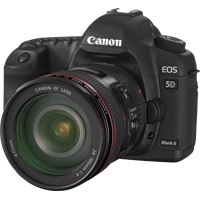- Typically, a legend is considered one-of-a-kind. It stands alone in its own place and during its own time. The next legend must create its own status as something unique and special; however, this can be difficult if you carry part of the same name as the original. This was the precarious position of the Canon EOS 5D Mark II DSLR camera when it was introduced during November 2008. The original 5D was an established legend, being the first full-frame camera with a body that looked a bit like a compact camera, with its integrated vertical grip.Read real customer reviews of the Canon EOS 5D Mark II here.

- To bring a new 5D to the market, Canon had to offer more than a simple upgrade. The 5D Mark II had to find its own loyal group of followers, and many of them. Plus, the 5D was three years old at that point and Canon was facing stiff competition from the newer Nikon D700 and Sony A900. All indications are that the 5D Mark II has generated a loyal following, especially among wedding photographers, and has proven to be one of the best values for its price, scoring very high in image quality. In addition, any 5D user who wants more of what they’ve enjoyed in that camera will certainly find it in the 5D Mark II. Upgrading for 5D owner is any easy decision.
- Canon made sure the changes to the 5D Mark II were more than mere upgrades. The camera’s 21.1-megapixel full-frame CMOS sensor is just a bit more than a third larger than the 5D’s. In fact, it’s more like the sensor in the 1Ds Mark III and many experts and reviewers think it outperform that sensor in a number of subtle ways.
- Although the 5D Mark II has the same DIGIC 4 image processor as the 5D, the processor performs “better” in the Mark II because its working in partnership with a much bigger sensor. The 21 megapixels of data can be processed faster at as much as 3.9 frames per second.
- To match the increased demands of serious amateurs and pros three years after the 5D, the 5D Mark II was given a considerable greater ISO sensitivity range of 50 to 25,600. Wedding photographers are a specific class of photographers who benefit substantially from this ISO increase.
- The 5D Mark II also satisfies another need for speed by the pros. The mirror doesn’t drop between exposures when contrast-detect AF is activated. This significantly reduces shutter lag and any exposure noise.
- Pros can’t afford a dirty sensor, either, which is why Canon added its EOS Integrated Cleaning System to the 5D Mark II. This helps to establish this camera’s separate legend, since the original 5D was notorious for gathering dust on the sensor.
- To be competitive, the 5D Mark II had to include a Live View capability as well as both passive AF and contrast-detect AF. Canon took one more step, which the many photographers shooting people pictures applaud, and that was to give the camera face-detect AF too. Live View also extends to video recording in either 1080p or VGA size.
- The 5D Mark II’s video function hasn’t lost much, if any, steam three-plus years after the camera hit the market. At the time, it was only the second DSLR recording 1080p HD. Video format is Quicktime MOV with the H.264 codec, with PCM for audio. The 5D Mark II is another DSLR with high-end video features that were considered a bit of a novelty at the time. Now that pros are taking a serious look at still photography and video in the same camera, the 5D Mark II is actually more of a value than when original released. It’s an excellent dual-creative opportunity to merge the mediums that so many pros are doing to become a new breed of multimedia vision makers.
- Image quality is where the value of a camera actually counts, especially for pros; and the Canon EOS 5D Mark II has received kudos from both them and many third-party reviewers as good, if not, as better than its primary competition at the time. Being that its price point puts it in the middle of the pack, the resolution and image quality can only be beaten by cameras that cost many thousands more. Most serious enthusiasts, semi-pros and pros don’t require much more than what the 5D Mark II produces. The big-ticket DSLRs are only required by a small percentage of specialized professionals, making the Canon EOS 5D Mark II still one of the best cameras in the marketplace.
- The Canon EOS 5D Mark II is even more of a bargain if you order yours by March 3, 2012, from B&H Photo Video. You’ll save $100 with this limited-time offer, paying just $2,157 for the body only. Add the Canon 24–105mm f/4 L IS USM AF lens and the price is only $2,834, with the $100 instant savings. For more information, visit
Your feedback is important to thousands of PhotographyTalk.com fans and us. If this article is helpful, then please click the Like and Re-Tweet buttons at the top left of this article.
Photo by: Copyrights @ 2012 canon.inc
This article about "Canon EOS 5D Mark II DSLR Camera" was first published on our website here https://www.photographytalk.com/photography-equipment-reviews/2090-11-ways-the-canon-eos-5d-mark-ii-dslr-camera-became-its-own-legend